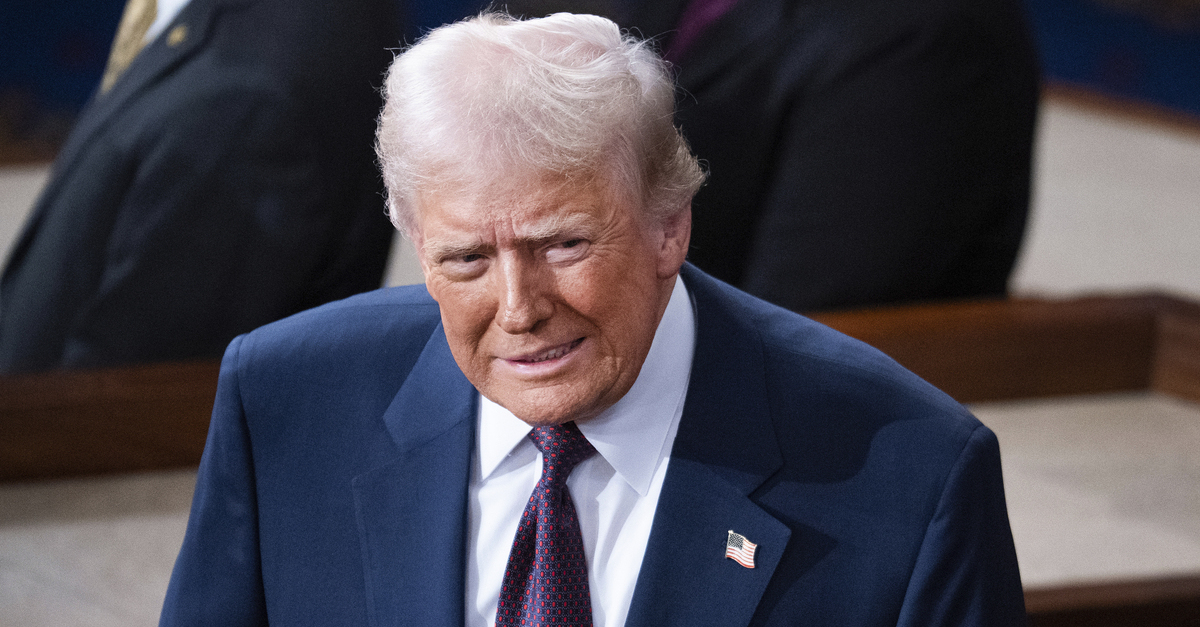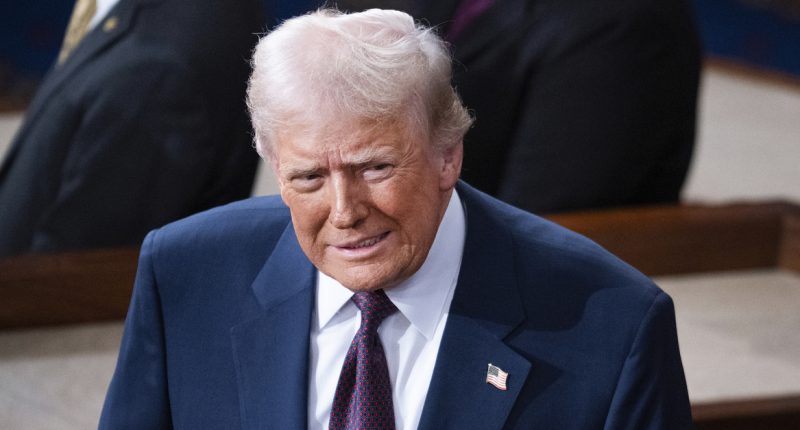
UNITED STATES – MARCH 4: President Donald Trump arrives to deliver his address to a joint session of Congress in the House Chamber of the U.S. Capitol on Tuesday, March 4, 2025 (Tom Williams/CQ Roll Call via AP Images).
A federal court of appeals on Thursday upheld a preliminary injunction barring the government from instituting a controversial spending freeze issued during the nascent days of the Trump administration.
In a 48-page order, the U.S. Court of Appeals for the First Circuit rejected a bid to temporarily stay the injunction issued by U.S. District Judge John McConnell, a Barack Obama appointee, on March 6.
The appeals court painstakingly recited the “unusually involved procedural history” of the case in an effort to analyze the issues — and, in the end, found the Trump administration had not made much of an argument for why the lower court’s ruling should be dissolved.
In the case, the district court previously issued a temporary restraining order. The government was twice accused of violating the restraining order — and the judge found those allegations credible each time. The government then twice tried to have the restraining order stayed by the First Circuit Court of Appeals and failed each time.
“[W]e deny the motion for a stay pending appeal of the District Court’s preliminary injunction,” Chief Circuit Judge David J. Barron, who was also appointed by Obama, concluded in the opinion.
The litigation challenges the often murky directives issued to numerous administrative agencies in response to a series of executive orders and the infamous Office of Management and Budget (OMB) memo mandating a “temporary pause” on federal spending.
The order containing the injunction bars the government from “from reissuing, adopting, implementing, giving effect to, or reinstating under a different name the directives” in the spending freeze guidance. That order also found the Trump administration likely violated several tenets of the Administrative Procedure Act (APA), other federal laws that mandate the distribution of congressionally-appropriated funds, and key aspects of the U.S. Constitution.
One key aspect of the case is the speed with which the OMB memo was rescinded. But, ultimately, that rescission did not much inure to the government’s benefit — and perhaps did the opposite.
To heard the plaintiffs tell it, the government kept on with its plans and used the rescission as window dressing. The district court agreed with the plaintiffs, crediting statements that several agencies went ahead with spending freezes after the memo was withdrawn.
Still, the government maintains the withdrawal of the OMB memo was relevant — because of how the plaintiffs, several states led by New York Attorney General Letitia James, have fashioned their case over time.
That argument did not prove availing.
“[T]he Defendants seek to stay the injunction in its entirety, notwithstanding their expressed choice to develop no argument in their stay motion that they are likely to succeed in showing that the District Court’s analysis of the OMB Directive was mistaken,” Barron drily observes.
In their appeal, U.S. Department of Justice lawyers complained that the plaintiffs transmogrified the APA claim against the OMB — initially based on the memo alone — into a plea for “broad-based relief against innumerable funding decisions at twenty-three federal agencies” and that “such broad-based APA challenges” are not allowed.
The appellate court was not convinced by this argument — either the complaints of shape-shifting or the merits themselves.
“The thrust of this line of argument thus appears to be that the preliminary injunction rests on a broad programmatic attack rather than on challenges to discrete final agency actions,” the judge muses.
But, the judge explains, after consulting relevant precedent, an “attack” on a government “program” under an APA lawsuit is only prohibited in situations where the program in question refers, in something like informal language or shorthand, to “the continuing (and thus constantly changing) operations” of the government.
Here, the district court found the plaintiffs actually did fashion their APA lawsuit as a series of challenge to discrete and final actions.
“To be sure, those claims, like the motion for the preliminary injunction, describe those actions, collectively, as the ‘Federal Funding Freeze,”” Barron writes. “The District Court at points uses that nomenclature as well. But the claims themselves, like the motion, assert that the discrete final agency actions are the decisions by the Agency Defendants to implement broad, categorical freezes on obligated funds.”
A secondary argument raised by the DOJ is that the plaintiff states improperly challenged “unidentified past funding decisions across thousands of programs and an untold number of hypothetical future funding decisions.”
The appellate court dismissed this government complaint as “a variation on the same theme” of the rejected APA defense.
And here, the judge is unsparing.
“To the extent that this argument is distinct from the one discussed above, we are not aware of any supporting authority for the proposition that the APA bars a plaintiff from challenging a number of discrete final agency actions all at once,” Barron continues. “Nor do the movants identify any such precedent.”
For the sake of argument, the court dips half a toe into this argument — noting that the government says the states did not, in their own appellate briefing, challenge any “specific agency actions other than the rescinded” OMB memo — and then quickly rubbishes the line of thought as procedurally useless. That’s because such an allegation of that sort at this stage does not speak to why “the circumstances” at large justify undoing an injunction.
The judge also says the claim is factually unsound.
From the opinion, at length:
In any event, the Plaintiff-States’ opposition does identify specific agency actions. The Plaintiff-States make clear that they challenge the Agency Defendants’ “actions — following the executive orders and [OMB] Directive — to implement categorical funding freezes without regard and contrary to legal authority.” The Defendants’ contention about the deficiencies in the Plaintiff-States’ opposition to the stay motion also must be considered in light of the fact that, as we have already explained, the stay motion does not address the District Court’s findings regarding the final agency actions that undergird the preliminary injunctive relief.
Indeed, the record before the District Court included numerous notices and emails authored by Agency Defendants that support the finding that their funding freezes were categorical in nature, rather than being based on “individualized assessments of their statutory authorities and relevant grant terms.” The Plaintiff-States also attached numerous declarations describing pauses, freezes, and sudden terminations of obligated funds that suggested that these actions were taken pursuant to such categorical decisions.
Love true crime? Sign up for our newsletter, The Law&Crime Docket, to get the latest real-life crime stories delivered right to your inbox.




